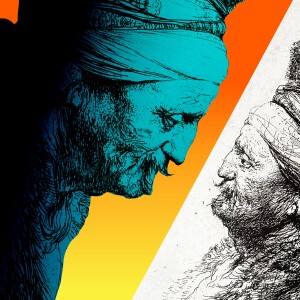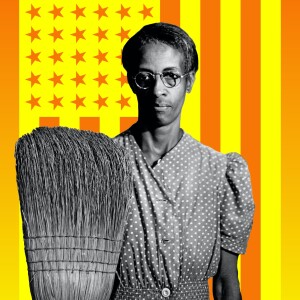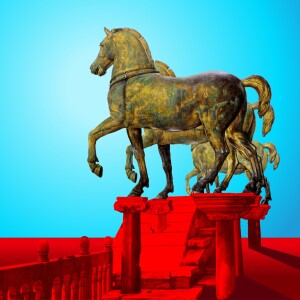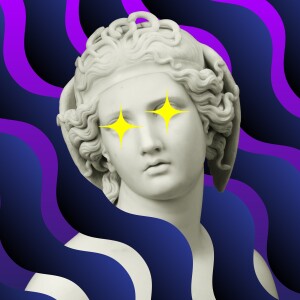Episodes

Wednesday Mar 02, 2022
Wednesday Mar 02, 2022
In 1852, Harriet Hosmer packs her pistol, her anatomy degree, and two pictures of a sculpture she made and moves to Rome. There, among other “emancipated women” in the expat colony, she becomes one of the world’s most famous artists. But it’s the spirit world that truly calls to her, the realm of the dead that she channels through clairvoyance and seances. So what happens when she answers? (This episode first aired in June 2021. New season begins March 14.)
You can see Hosmer's remarkably tender sculpture of Medusa, now on view in the "Supernatural America" exhibition at the Minneapolis Institute of Art, in the online collection: collections.artsmia.org/art/81074/med…oodhue-hosmer

Monday Feb 14, 2022
Monday Feb 14, 2022
Elizabeth Catlett, the granddaughter of enslaved African-Americans, is a struggling artist at the height of Jim Crow. But when she moves to Mexico City in 1946, she finds love, inspiration, and eventually fame. There's just one catch: she can't come home. (This episode first aired in March 2020.) New season begins March 14.
Check out her work in the collection of the Minneapolis Institute of Art: https://collections.artsmia.org/art/7890/sharecropper-elizabeth-catlett

Monday Jan 17, 2022
Monday Jan 17, 2022
“It’s never too late to have a happy childhood,” wrote Tom Robbins, the novelist. He could have been referring to Henri Rousseau, the fin de siècle autodidact who begins painting seriously in retirement: storybook-style scenes of exotic animals and jungles that eventually catch the eye of Picasso and Matisse. A story worth remembering as you contemplate a new year, same as the old year—or not.
You can see a print of Rousseau’s “War,” a possible inspiration for Picasso’s “Guernica,” in the collection of the Minneapolis Institute of Art: https://collections.artsmia.org/art/7859/la-guerre-henri-rousseau
You can see one of Rousseau’s most iconic works, “The Dream,” in the collection of the Museum of Modern Art: https://www.moma.org/collection/works/79277
A new season of The Object starts soon. Subscribe now and be among the first to hear it.

Monday Dec 20, 2021
Monday Dec 20, 2021
It’s good to be the pope in the 1600s. But staying pope is not so easy, as the famous Barberini family finds out when one of their own takes up the tiara in 1623. As Rome fills up with their art, and dungeons fill up with their enemies, can they survive the forces of change threatening their worldview—and the forces of the occult threatening to kill the pope on Christmas Day?
You can see some of the art commissioned by the Barberini family, including Pope Urban VIII, all over Rome—in the Piazza Barberini, the Palazzo Barberini, and of course St. Peter’s Basilica—and also in the collection of the Minneapolis Institute of Art: https://collections.artsmia.org/search/pope%20urban
Look closely and you may see the curious Barberini family crest—a trio of bees—on fountains, frames, and even the altar in St. Peter’s Basilica. Read about its symbolism and ubiquity here: https://theframeblog.com/2017/08/22/bees-in-the-frame-part-1-the-barberini-bee/

Monday Nov 15, 2021
Monday Nov 15, 2021
Rembrandt and Lievens were friends and foes, two of the most promising artists of the Dutch Golden Age. But like Mozart and Salieri, one is remembered as an all-time great, the other is mostly forgotten. Only now is the true story of Rembrandt’s rival being told--a story of ego and admiration, tragedy and triumph, forgery and greed. And it’s rewriting everything we know about the master and the nature of genius.
You can see one of Rembrandt's etchings made after his rival's original here: https://collections.artsmia.org/art/55345/the-second-oriental-head-rembrandt-harmensz-van-rijn
Here you can see Rembrandt's reworking of his image of Christ presented for judgement, after suffering the wrath of the Church: https://collections.artsmia.org/art/115357/christ-presented-to-the-people-rembrandt-harmensz-van-rijn

Monday Oct 18, 2021
Monday Oct 18, 2021
When Gordon Parks becomes the first Black photographer at LIFE magazine, in 1949, he’s determined to show the full measure of Black lives in America. Whether the magazine, and the rest of America, is ready or not.
You can see "American Gothic," Parks’ photograph of Ella Watson that is featured in this episode, in the collection of the Minneapolis Institute of Art: https://collections.artsmia.org/art/100557/american-gothic-gordon-parks
You can see a variety of other work by Parks, who began his career in Minnesota, here: https://collections.artsmia.org/search/artist:%22Gordon%20Parks%22

Monday Sep 13, 2021
Monday Sep 13, 2021
When World War II begins, Lee Miller is one of the most sought-after women in the world--a celebrated model, an irresistible muse, and an emerging photographer in her own right. So why does she trade the high life for the front line, risking everything to become the only female photojournalist allowed in combat?

Monday Aug 09, 2021
Monday Aug 09, 2021
In the early 1800s, the four famous bronze horses of Venice are restored to their place atop St. Mark's Basilica, after a long and humiliating absence. But when American artist Charles Caryl Coleman arrives in Venice, in the 1870s, his celebrated painting of the horses exposes some clues to their real origins. A story of empire and theft, and a betrayal that forever changed the world.
You can see the painting by Coleman, The Bronze Horses of San Marco, in the collection of the Minneapolis Institute of Art: https://collections.artsmia.org/art/2607/the-bronze-horses-of-san-marco-charles-caryl-coleman
This episode features a clip from the podcast Curious Objects, from Antiques magazine. Listen to more at https://www.themagazineantiques.com/podcast/

Monday Jul 12, 2021
Monday Jul 12, 2021
Mademoiselle Lange is the first celebrity actress in France, as famous for her lovers as her looks. But when the French Revolution roils the country, she is forced to fight for her life, and meets her match in a rising artist who is commissioned to paint her portrait. A picture that will upend both their lives--and the art world--in dramatic fashion.
You can see the scandalous portrait mentioned in this episode, "Portrait of Mlle. Lange as Danae," here in the collection of the Minneapolis Institute of Art: https://collections.artsmia.org/art/1727/portrait-of-mlle-lange-as-danae-anne-louis-girodet-de-roussy-trioson

Monday Jun 07, 2021
Monday Jun 07, 2021
In 1852, Harriet Hosmer packs her pistol, her anatomy degree, and two pictures of a sculpture she made and moves to Rome. There, among other “emancipated women” in the expat colony, she becomes one of the world’s most famous artists. But it’s the spirit world that truly calls to her, the realm of the dead that she channels through clairvoyance and seances. So what happens when she answers?
You can see her remarkably tender sculpture of Medusa, referenced in this episode, in the collection of the Minneapolis Institute of Art: https://collections.artsmia.org/art/81074/medusa-harriet-goodhue-hosmer
Learn more about “Supernatural America,” the exhibition organized by the Minneapolis Institute of Art and featuring Hosmer’s Medusa, opening June 2021 at the Toledo Museum of Art:
https://new.artsmia.org/exhibition/supernatural-america-the-paranormal-in-american-art
